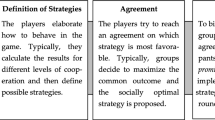Abstract
This paper investigates the role of tolerance in urban communication. In doing so, it presents a model with \(N+1\) individuals who communicate with each other. The model explains that individuals can be tolerant and obtain a valuable outcome if their communication partners are also tolerant enough to make their communication smooth. Consequently, when individuals are sufficiently differentiated and have frequent opportunities to communicate, there exist multiple equilibria in which all individuals could be either tolerant or intolerant. That is, individuals remain less tolerant as long as their communication partner’s tolerance remains at very low level. However, when their communication partners are initially tolerant enough, they can achieve a substantial outcome in communication. This phase can be interpreted as meaning that the individual has exercised intercultural competence.



Similar content being viewed by others
Notes
The critical values of \(\rho \), ln2/ln3 and 3/4, depend on the assumption of utility function. If we consider different preferences for communication with oneself and with others, these critical values will change.
In this paper, we mainly interpret the substitution parameter \(\rho \) as the difference among individuals. This interpretation becomes more reasonable when we focus on task-oriented communication that plays an important role in agglomeration economies in cities. However, generally speaking, this argument can be applied to other cases including relationship-based communication such as among family members, friends, and neighbors.
In case (i) in Fig. 1, it is clear that every individual maximizes tolerance so as to enjoy the highest utility, except the case of \(\tau _i =0\). In cases (iii) and (iv), on the other hand, every individual minimizes tolerance so as to increase their utility.
It is noteworthy that the multiple equilibria will disappear if individuals can enjoy the outcome from the communication started by others. For instance, if we assume the utility function such as \(U_i =\left[ {(c_{ii}^D )^{\rho }+(c_{ij}^D )^{\rho }+(c_{ij}^R )^{\rho }} \right] ^{1/\rho }\), the indirect utility becomes \(V_i =\left( {1+2\phi _{ij}^{\rho /(1-\rho )} } \right) ^{(1-\rho )/\rho }\), which increases with \(\phi _{ij} \). Consequently, the increase in tolerance is always beneficial for every individual; thus, \(\phi _{ij} =0\) is not chosen in equilibrium. This case would correspond with the communication between close friends, family, and so on, rather than the task-oriented communication in offices.
We assume that the level of tolerance, \(\tau _i \), is the same for all the other individuals.
The choice of tolerance is related to the discussion about social capital in sociology. Social capital means a concept that facilitates social interaction and solves the dilemmas of collective action in societies. For instance, Putnam et al. (1994) observes that the south regions in modern Italy are less active than the north, in terms of social performance: political and economic activities, literature, art, and so on. He concludes that the stagnancy in the south results from the lack of social capital given by trustworthiness, expectation, norms, and so on.
References
Bellini E, Ottaviano GIO, Pinelli D, Prarolo G (2013) Cultural diversity and economic performance: evidence from European regions. In: Crescenzi R, Percoco M (eds) Geography, institutions and regional economic performance. Springer, Berlin, pp 121–141
Bennett MJ (1986) A developmental approach to training for intercultural sensitivity. Int J Intercult Relat 10:179–196
Bennett MJ (1993) Towards ethnorelativism: a developmental model of intercultural sensitivity. In: Paige RM (ed) Education for the intercultural experience, 2nd edn. Intercultural Press, Yarmouth, pp 21–71
Bennett MJ (2013) Intercultural adaptation. In: Bennett MJ (ed) Basic concepts of intercultural communication: paradigms, principles, and practices. Intercultural Press, Boston, pp 83–103
Bennett MJ, Bennett JM (2004) Developing intercultural sensitivity: an integrative approach to global and domestic diversity. In: Landis D, Bennett J, Bennett M (eds) Handbook of intercultural training, 3rd edn. Sage, Thousand Oaks, pp 147–165
Berliant M, Fujita M (2008) Knowledge creation as a square dance on the Hilbert cube. Int Econ Rev 49:1251–1295
Berliant M, Fujita M (2011) Culture and diversity in knowledge creation. Munich Personal RePEc Archive
Borjas GJ (1995) The economic benefit of immigration. J Econ Perspect 9:3–22
Borjas GJ (2003) The labour demand curve is downward sloping: reexamining the impact of immigration on the labour market. Q J Econ CXVIII(4):1335–1374
Coleman JS (1990) Foundations of social theory. Harvard University Press, Cambridge
Floria R (2002) The rise of the creative class: and how it’s transforming work, leisure, community and everyday life. Basic Books, New York
Ioannides Y (2012) From neighborhood to nations: the economics of social interactions. Princeton University Press, Princeton
Jackson MO (2008) Social and economic networks. Princeton University Press, Princeton
Jackson MO, Wolinsky A (1996) A strategic model of social and economic networks. J Econ Theory 71:44–74
Jacobs J (1969) The economy of cities. Vintage Books, New York
Marshall A (1890) Principles of economics. Macmillan, London
Ottaviano GIP, Peri G (2006) The economic value of cultural diversity: evidence from US cities. J Econ Geogr 6:9–44
Ottaviano GIP, Prarolo G (2009) Cultural identity and knowledge creation in cosmopolitan cities. J Reg Sci 49:647–662
Putnam DP, Leonardi R, Nanetti RY (1994) Making democracy work: civic traditions in modern Italy. Princeton University Press, Princeton
Sparber C (2009) Racial diversity and aggregate productivity in US industries: 1980–2000. South Econ J 75:829–856
Acknowledgments
We are grateful to the participants of our presentation at European Regional Science Association (Lisbon School of Economics and Management) and anonymous referees for their valuable comments.




